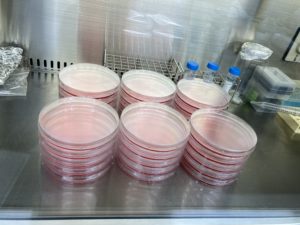miRNA/siRNA-directed pathway to produce noncoding piRNAs from endogenous protein-coding regions ensures Drosophila spermatogenesis

大阪大学大学院生命機能研究科の井木太一郎准教授と甲斐歳恵教授らの研究グループは、タンパク質をコードする配列が、機能性の非コード RNA の合成に転用される現象を発見しました。「非コード化」と名付けられた本現象が精子の形成において重要な役割を担うことを、ショウジョウバエを用いて明らかにしました。
PIWI-interacting RNA (piRNA) pathways control transposable elements (TEs) and endogenous genes, playing important roles in animal gamete formation. However, the underlying piRNA biogenesis mechanisms remain elusive. Here, we show that endogenous protein coding sequences (CDSs), which are normally used for translation, serve as origins of noncoding piRNA biogenesis in Drosophila melanogaster testes. The product, namely, CDS-piRNAs, formed silencing complexes with Aubergine (Aub) in germ cells. Proximity proteome and functional analyses show that CDS-piRNAs and cluster/TE-piRNAs are distinct species occupying Aub, the former loading selectively relies on chaperone Cyclophilin 40. Moreover, Argonaute 2 (Ago2) and Dicer-2 activities were found critical for CDS-piRNA production. We provide evidence that Ago2-bound short interfering RNAs (siRNAs) and microRNAs (miRNAs) specify precursors to be processed into piRNAs. We further demonstrate that Aub is crucial in spermatid differentiation, regulating chromatins through mRNA cleavage. Collectively, our data illustrate a unique strategy used by male germ line, expanding piRNA repertoire for silencing of endogenous genes during spermatogenesis.
Authors: Taichiro Iki, Shinichi Kawaguchi, and Toshie Kai
Journal: Science Advances, 2023, 9:29
投稿者プロフィール

最新の投稿
ノンドメインブログ2025.08.07越し方 行く末 The Way Behind, the Way Ahead
 令和7年度(FY2025)2025.04.25In silico screening by AlphaFold2 program revealed the potential binding partners of nuage-localizing proteins and piRNA-related proteins
令和7年度(FY2025)2025.04.25In silico screening by AlphaFold2 program revealed the potential binding partners of nuage-localizing proteins and piRNA-related proteins 令和6年度(FY2024)2025.04.25piRNA processing within non‐membrane structures is governed by constituent proteins and their functional motifs
令和6年度(FY2024)2025.04.25piRNA processing within non‐membrane structures is governed by constituent proteins and their functional motifs 令和6年度(FY2024)2024.07.18HemK2 functions for sufficient protein synthesis and RNA stability through eRF1 methylation during Drosophila oogenesis
令和6年度(FY2024)2024.07.18HemK2 functions for sufficient protein synthesis and RNA stability through eRF1 methylation during Drosophila oogenesis


